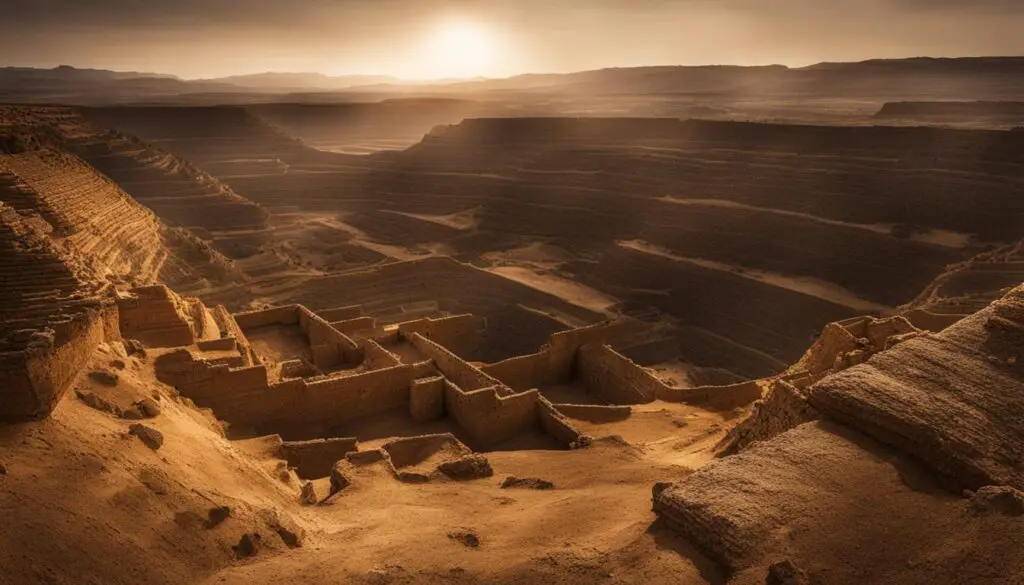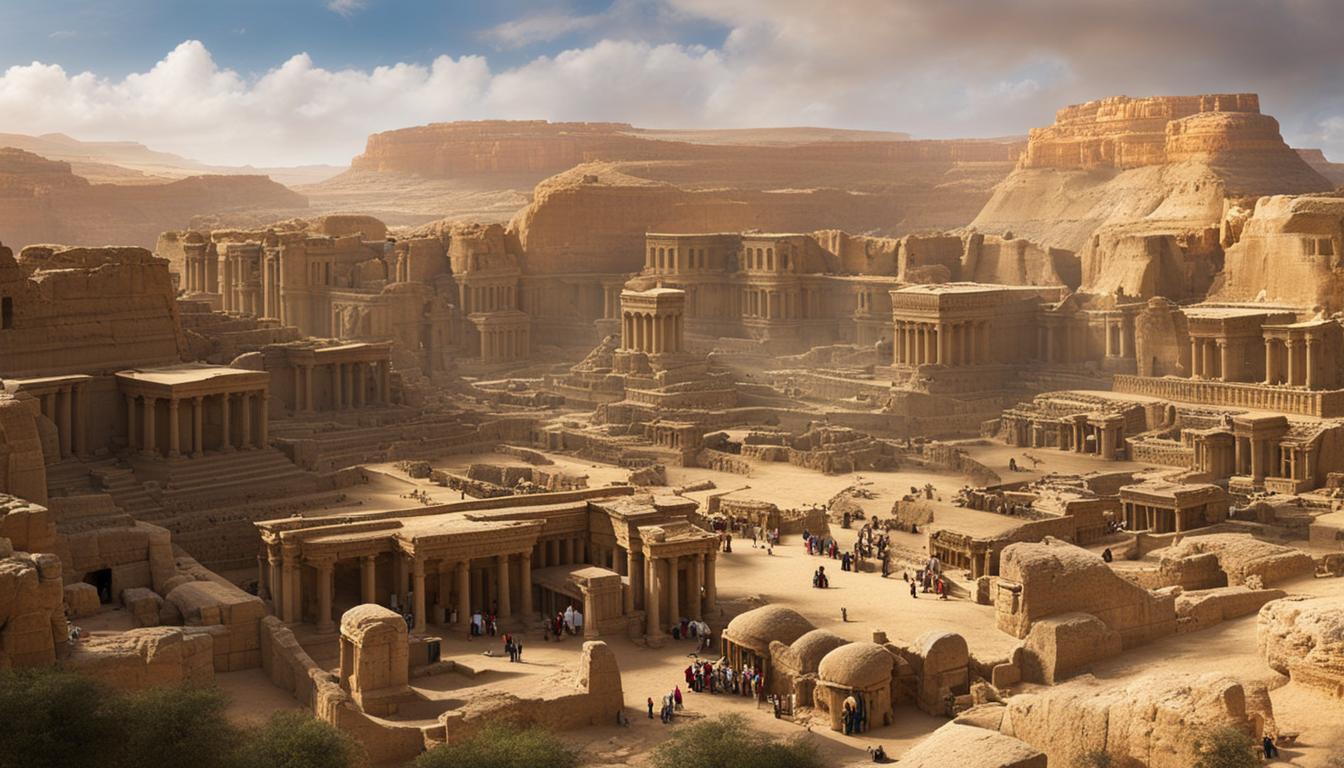Welcome to our comprehensive guide on Edom, an ancient kingdom with a rich history and vibrant culture. In this article, we will delve into the definition and meaning of Edom, its fascinating history, biblical references, notable figures, geography, major events, archaeological sites, and its relevance in modern times. Join us on this journey as we uncover the mysteries of Edom’s past and explore the legacy it has left behind.
Key Takeaways:
- Edom was an ancient kingdom located in Transjordan, known for its close connection to the Hebrews.
- It holds biblical importance, mentioned numerous times in the Old Testament, with a complex relationship with the Israelites.
- Notable biblical figures linked to Edom include Esau and his descendants who ruled as kings and leaders of the Edomite tribes.
- Geographically, Edom occupied a strategic location with its main capital in Bozrah, modern-day Buseirah.
- Major biblical events, such as the conquest by the Babylonians, shaped Edom’s history and led to the exile of the Edomites.
- Today, the ancient kingdom of Edom no longer exists as a distinct political entity, but its legacy lives on through archaeological remains and cultural connections.
The Biblical Importance of Edom
Edom holds significant biblical importance as it is mentioned numerous times in the Old Testament. The Edomites were considered descendants of Esau, the twin brother of Jacob (Israel), and are referred to as “brothers” to the Israelites.
However, the relationship between the Edomites and Israelites was often characterized by conflict and enmity. The Bible recounts various episodes involving interactions between the Edomites and Israelites, shedding light on the religious, cultural, and political dynamics of the region during biblical times.
“For the violence against your brother Jacob, shame shall cover you, and you shall be cut off forever.” – Obadiah 1:10
These biblical references showcase the historical significance of Edom and its role in shaping the narrative of the Israelites. The tensions and conflicts between these two peoples reflect the broader sociopolitical landscape of the ancient Near East, providing valuable insights into the religious and cultural dynamics of the region.
Table: Key References to Edom in the Bible
| Biblical Book | Reference |
|---|---|
| Genesis | Esau’s descendants and their territories (Genesis 36) |
| Exodus | Israel’s interactions with Edom during the Exodus (Exodus 15:15; Numbers 20:14-21) |
| 2 Samuel | Edomite kings and their dealings with Israel (2 Samuel 8:13-14) |
| Obadiah | Prophecy against Edom and its downfall (Obadiah 1:1-21) |
The biblical importance of Edom extends beyond its historical role, offering valuable insights into the religious, cultural, and political dynamics of the ancient Near East.
Notable Biblical Figures Linked to Edom
Edom, an ancient kingdom in the region of Transjordan, had several notable biblical figures associated with it. These figures played significant roles in the history and culture of Edom, leaving their mark on the region’s narrative.
Esau
“Esau, the progenitor of the Edomites, was the elder twin brother of Jacob (Israel). He is described in the Bible as a skillful hunter and a man of the field. Esau’s descendants, the Edomites, inherited his role as the ruling class of Edom, establishing a line of kings and leaders.”
Edomite Kings and Leaders
Throughout the course of Edom’s history, there were several kings and leaders who left their mark on the kingdom. These leaders include Bela ben Beor, Jobab ben Zerah, Husham, Hadad ben Bedad, Samlah, Saul, Baal-hanan ben Achbor, and Hadar. They ruled over the various Edomite tribes before the establishment of Israelite kings.
Edomite Tribes
The Edomites were organized into various tribes, each with its own leadership structure. The Bible mentions different Edomite tribes such as Teman, Amalek, Kenaz, and Korah. These tribes played a vital role in the social and political dynamics of Edom, contributing to the kingdom’s overall identity and governance.
| Biblical Figures | Role |
|---|---|
| Esau | Progenitor of the Edomites |
| Bela ben Beor | Edomite King |
| Jobab ben Zerah | Edomite King |
| Husham | Edomite King |
| Hadad ben Bedad | Edomite King |
| Samlah | Edomite King |
| Saul | Edomite King |
| Baal-hanan ben Achbor | Edomite King |
| Hadar | Edomite King |
Geography and Function of Edom in Biblical Times
During biblical times, Edom occupied a strategic location in the Levant, with its territory extending between Moab and the Arabah. The main capital of Edom was Bozrah, situated in modern-day Buseirah near the southern end of the Dead Sea. The region was characterized by rugged highlands, deep ravines, and natural rock fortresses, such as es-Sela. These geographic features contributed to the defensive character of the kingdom, making it a formidable stronghold in the ancient world. Edomites also settled in other areas of the territory, including the southern hills of Judea and parts of the Negev.
The function of Edom in biblical times varied as it served as a crucial trade route connecting Egypt to the north and Arabia to the south. The region’s strategic geographic position facilitated the movement of goods, people, and ideas. Additionally, Edom was known for its agricultural activities, particularly in the fertile areas of its territory. The cultivation of crops and the rearing of livestock contributed to the economic prosperity of the kingdom. Edom’s natural resources, including its copper mines, also played a vital role in sustaining its economy and trade relations with neighboring regions.
The geographic and functional aspects of Edom in biblical times influenced its interactions with neighboring kingdoms and peoples. Its defensive landscape and strategic location made it a target for conquest and conflict, leading to various territorial disputes and power struggles. The geographical features of Edom also shaped the development of its unique culture and architecture, evident in the remains of its cities and fortresses discovered through archaeological excavations. Understanding the geography and function of Edom during biblical times provides valuable insights into the social, economic, and political dynamics of the region.

Edom in the Bible
The biblical accounts highlight the significance of Edom in various narratives. Edom is mentioned numerous times in the Old Testament, depicting the complex relationship between the Edomites and Israelites. The conflicts and interactions between these two groups shaped the religious, cultural, and political dynamics of the region. The biblical references to Edom provide insights into the religious practices, societal structures, and historical events that occurred in the kingdom. These accounts contribute to our understanding of the ancient world and the cultural significance of Edom in biblical times.
Table: Edomite Settlements in Biblical Times
| Settlement | Location |
|---|---|
| Bozrah | Near the southern end of the Dead Sea |
| Judean Hills | Southern portion of the Judean Mountains |
| Negev | Southern desert region of Israel |
The table above highlights some of the major settlements of Edom during biblical times. Bozrah served as the capital and represented the heart of the kingdom. The Judean Hills and Negev were additional areas where Edomites established settlements, contributing to the expansion and influence of the kingdom in the region. These locations played a significant role in shaping the cultural and historical development of Edom.
Major Biblical Events in Edom and Their Impact on Its History
Edom, with its rich biblical history, witnessed several significant events that shaped its destiny. These major biblical events in Edom include conquests, defeats, and exile, which had a profound impact on the region. Let us delve into these events and explore their significance.
Edomite Conquests
Throughout its existence, Edom embarked on various conquests to expand its territory and exert its influence in the region. These conquests brought the Edomites into conflict with neighboring powers, including the Israelites, Egyptians, and Assyrians. The Edomites displayed military prowess, enabling them to establish their dominance over certain areas and assert control over trade routes.
Edomite Defeat
Despite their military successes, the Edomites also faced defeats at the hands of formidable opponents. The biblical accounts recount instances where the Edomites were defeated and subjugated by foreign powers, leading to temporary loss of autonomy and control over their territory. These defeats underscore the complex political dynamics of the region and the fluctuating power dynamics between rival kingdoms.
Edomite Exile
A significant turning point in Edom’s history was the Babylonian conquest, which resulted in the destruction of the kingdom and the exile of the Edomites. The Babylonian Empire, under the rule of Nebuchadnezzar II, captured Edom and dispersed its people, leading to the assimilation of the Edomites into other cultures. This event marked the end of Edom as an independent political entity and had lasting repercussions on the region.
These major biblical events in Edom demonstrate the turbulent history of the region and its interactions with neighboring powers. The conquests, defeats, and exile of the Edomites shaped the political, social, and cultural landscape of Edom, leaving a lasting impact that reverberates through the annals of history.
| Event | Impact |
|---|---|
| Edomite Conquests | Expansion of territory and influence |
| Edomite Defeat | Loss of autonomy and control |
| Edomite Exile | Destruction of the kingdom and assimilation of the Edomites |
Ancient Edomite Civilization and Culture
The ancient Edomite civilization was a vibrant and distinct culture that flourished in the region of Edom during biblical times. The Edomites, descended from Esau, played a significant role in the history of the Levant and their culture showcased unique characteristics.
Edomite society was hierarchical with kings and chieftains leading the tribes. They engaged in various economic activities, such as copper mining and agriculture, which contributed to their prosperity. The Edomites also had a strong influence from their neighboring civilizations, including the Egyptians and Assyrians, which can be seen in their cultural practices and traditions.
Quote: “The Edomites had a rich religious tradition and worshipped deities like the storm god Hadad, who played a central role in their religious beliefs.”
The Edomite civilization thrived in a region known for its rugged highlands, deep ravines, and natural rock fortresses. This geographical setting provided them with a defensive advantage, shaping their society as a kingdom characterized by its defensive character.
| Edomite Civilization | Edomite Culture | Ancient Edomites | Edomite Society |
|---|---|---|---|
| The ancient civilization that thrived in the region of Edom during biblical times. | The unique practices and traditions of the Edomite people, influenced by neighboring civilizations. | The descendants of Esau, closely related to the Hebrews, who ruled as kings and leaders. | The hierarchical society with kings and chieftains leading the tribes. |
| The Edomites engaged in economic activities like copper mining and agriculture. | The cultural practices, traditions, and religious beliefs of the Edomite civilization. | The Edomites were part of the wider Canaanite culture prevalent in the region. | The society shaped by the geographical features of the region, with a defensive character. |
| Edom occupied a strategic location in the Levant, characterized by rugged highlands and natural fortresses. | The Edomites worshiped deities like the storm god Hadad. | The Edomite civilization thrived in the Late Bronze Age and early Iron Age. | The Edomite society flourished in the region, with economic and cultural exchanges with neighboring civilizations. |
Archaeological Sites of Edom
The ancient kingdom of Edom left behind numerous archaeological sites that provide valuable insights into its history and civilization. These sites serve as tangible evidence of the kingdom’s existence and shed light on the culture, architecture, and daily life of the Edomites.
One of the most significant archaeological sites associated with Edom is the capital city of Bozrah, located in modern-day Buseirah. Excavations at this site have uncovered remains of buildings, fortifications, and pottery dating back to the time of the Edomites. The discovery of an impressive defensive wall indicates the strategic importance of Bozrah as a stronghold in the region.
Another notable site is es-Sela, an ancient mountaintop fortress renowned for its extensive fortifications. Situated in a rocky ridge, es-Sela boasts a complex network of walls, towers, and gates that provide valuable insights into the defensive strategies employed by the Edomites. The site also features rock-cut chambers, cisterns, and tombs, showcasing the architectural prowess of the ancient Edomite civilization.
In the ancient city of Petra, known as Umm el-Biyara, excavations have revealed an enclave inhabited by the Edomites during the Iron Age. The site showcases their adaptation to the region’s rugged topography, with rock-cut dwellings, water channels, and other architectural features that demonstrate their resourcefulness in harnessing the natural environment.

Archaeological Sites of Edom
| Site | Description |
|---|---|
| Bozrah (Buseirah) | The capital city of Edom, known for its defensive wall and ancient remains. |
| es-Sela | A mountaintop fortress with extensive fortifications and rock-cut chambers. |
| Umm el-Biyara (Petra) | An enclave inhabited by the Edomites, showcasing their adaptation to the rugged landscape. |
These archaeological sites offer a glimpse into the material culture and daily life of the Edomites. Through excavation and analysis, archaeologists have been able to piece together the story of this ancient civilization and uncover valuable artifacts that enhance our understanding of the historical and cultural context of Edom.
The Legacy of Edom: From the Ancient Kingdom to Modern Times
Edom, once a prominent kingdom in the ancient Near East, holds significant biblical importance and has left a lasting legacy. Throughout the Old Testament, Edom is mentioned repeatedly, showcasing its historical and cultural significance. Notable biblical figures linked to Edom include the descendants of Esau, such as Bela ben Beor and Hadad ben Bedad, who ruled as kings and leaders of the Edomite tribes.
In biblical times, Edom’s geography played a crucial role in shaping its function. Situated between Moab and the Arabah, the kingdom boasted a strategic location. Its capital, Bozrah, nestled near the southern end of the Dead Sea, served as a center of power and influence. The rugged highlands, deep ravines, and natural rock fortresses scattered across the region showcased Edom’s defensive character and highlighted the challenges faced by neighboring civilizations.
Several major biblical events impacted Edom’s history. The conquest of Edom by the Babylonians in the 6th century BC resulted in the kingdom’s destruction and the exile of the Edomites. Prior to this, conflicts with regional powers, including the Israelites and Egyptians, shaped the political landscape of Edom. These events led to shifts in power and ultimately contributed to the assimilation of the Edomites into the Jewish nation.
| Edom Today | Edomite Descendants | Edomite Legacy |
|---|---|---|
| While Edom no longer exists as a distinct political entity, its legacy lives on in modern times. | The descendants of the Edomites can still be found among the Jewish population, particularly in the southern regions of Israel and Jordan. | The rich history and cultural heritage of Edom continue to inform our understanding of the ancient societies of the Levant. The archaeological remains, biblical references, and cultural connections to the ancient civilization serve as reminders of the influence and significance of this once-thriving kingdom. |
The exploration of Edom’s history and culture provides valuable insights into the complexities of ancient societies, their interactions, and the fluidity of territorial boundaries. By delving into Edom’s past, we gain a deeper understanding of biblical narratives, political relationships, and the diverse civilizations that once flourished in the region. Today, Edom’s legacy stands as a testament to the enduring impact of this ancient kingdom.
The Significance of Edom’s History and Culture
The history and culture of Edom hold great significance in understanding the biblical narratives and the ancient societies of the Levant. By exploring Edom’s rich heritage, we gain valuable insights into the interactions between the Edomites and the Israelites, shedding light on the complexities of their religious, cultural, and political dynamics.
The cultural heritage of Edom is a testament to the vibrant civilization that once thrived in the region. The Edomites, with their unique practices and traditions, had a profound impact on the broader Canaanite culture of the time. From their agricultural pursuits to their engagement in copper mining, the Edomites left behind a material legacy that can be explored through archaeological sites and artifacts.
Understanding Edom’s legacy allows us to appreciate the fluidity of territorial boundaries and the ebb and flow of power in the ancient Near East. Major biblical events, such as the Edomite conquests and their subsequent defeat and exile, shaped the history of Edom and had far-reaching implications for the region. By delving into these events, we gain a deeper understanding of the socio-political landscape of biblical times.
| Biblical Figure | Role in Edomite History |
|---|---|
| Esau | The progenitor of the Edomites, closely related to the Israelites. |
| Bela ben Beor | One of the early kings of Edom, ruling before the establishment of Israelite kings. |
| Hadad ben Bedad | A prominent Edomite leader mentioned in the biblical accounts. |
| Jobab ben Zerah | An Edomite king who played a role in the history of Edom. |
“The history and culture of Edom offer a captivating glimpse into the ancient societies that once thrived in the Levant. It is through the study of Edom’s past that we can unravel the mysteries of this ancient kingdom, deepen our understanding of biblical narratives, and gain valuable insights into the complexities of the region’s history.”
The Impact of Major Biblical Events
The major biblical events that transpired in Edom had a profound impact on its history. The conquest of Edom by the Babylonians in the 6th century BC led to the destruction of the kingdom and the exile of the Edomites. This event marked a significant turning point, shifting the balance of power in the region and reshaping the political landscape. The conflicts between the Edomites and the Israelites, as documented in the Bible, highlight the rivalries and tensions that characterized the relationship between these neighboring peoples.
The significance of Edom’s history and culture extends beyond its biblical importance. By examining the material remains left by this ancient civilization, we gain a deeper understanding of the ancient Near East and the interconnectedness of its societies. Edom’s legacy serves as a reminder of the diverse civilizations that thrived in the region, leaving an indelible mark on the history and heritage of the Levant.

Conclusion
The history and culture of Edom hold significant biblical importance, providing valuable insights into the ancient societies of the Levant. As mentioned in the Old Testament, Edom was closely linked to the Israelites, though their relationship was often characterized by conflict and enmity. Notable biblical figures, including the descendants of Esau, played prominent roles in the history of Edom, ruling as kings and leaders of the Edomite tribes.
In biblical times, Edom occupied a strategic location between Moab and the Arabah, with Bozrah as its main capital. The region was known for its rugged highlands, deep ravines, and natural rock fortresses, which contributed to Edom’s defensive character. Major biblical events, such as the conquest of Edom by the Babylonians and conflicts with regional powers, had a profound impact on the history of Edom, leading to its destruction and the exile of the Edomites.
In modern times, the ancient kingdom of Edom no longer exists as a distinct political entity. However, the legacy of Edom lives on through the archaeological remains, biblical references, and cultural connections to the ancient civilization. Descendants of the Edomites can still be found among the Jewish population, particularly in the southern regions of Israel and Jordan. Exploring Edom’s history and culture enriches our understanding of ancient societies, biblical narratives, and the complexities of the Levant’s past.
FAQ
What is Edom?
Edom, also known as Idumea, was an ancient kingdom located in Transjordan. It was established in the 13th century BC and flourished until its destruction by the Babylonians in the 6th century BC.
Who were the Edomites?
The Edomites were descendants of Esau, the elder son of Isaac, and were closely related to the Hebrews. They are mentioned in various ancient sources, including the Bible and Egyptian and Assyrian inscriptions.
What is the biblical importance of Edom?
Edom holds significant biblical importance as it is mentioned numerous times in the Old Testament. The Edomites were considered descendants of Esau and are referred to as “brothers” to the Israelites. However, their relationship was often characterized by conflict and enmity.
Who were the notable biblical figures linked to Edom?
The notable biblical figures linked to Edom include Esau, the progenitor of the Edomites, and his descendants who ruled as kings and leaders of the Edomite tribes. Names such as Bela ben Beor, Jobab ben Zerah, Husham, Hadad ben Bedad, Samlah, Saul, Baal-hanan ben Achbor, and Hadar are mentioned in the biblical accounts.
Where was Edom located geographically?
Edom occupied a strategic location in the Levant, situated between Moab and the Arabah. Its main capital was Bozrah, located in modern-day Buseirah, near the southern end of the Dead Sea. Edomites also settled in other areas of the territory, including the southern hills of Judea and parts of the Negev.
What were the major biblical events in Edom?
One major event in Edom’s history is its conquest by the Babylonians in the 6th century BC, resulting in the destruction of the kingdom and the exile of the Edomites. Prior to this, Edomites were involved in conflicts with various regional powers, including the Israelites and the Egyptians.
What can archaeological sites tell us about ancient Edomite civilization?
Archaeological sites such as Bozrah, es-Sela, and Umm el-Biyara provide insights into the ancient Edomite civilization. These sites showcase the architectural, cultural, and defensive features of Edomite cities and fortresses, offering a glimpse into the material remains of this ancient civilization.
What happened to Edom in modern times?
The ancient kingdom of Edom no longer exists as a distinct political entity. The Edomites were assimilated into the Jewish nation during the Hasmonean period and later periods of Jewish history. Descendants of the Edomites can be found among the Jewish population, particularly in the southern regions of Israel and Jordan.
Why is the history and culture of Edom significant?
Exploring the history and culture of Edom offers valuable insights into the ancient societies of the Levant and their interactions with the Israelites. It helps deepen our understanding of biblical narratives, the complexities of ancient political relationships, and reinforces connections to the biblical texts.
What is the significance of Edom’s archaeological heritage?
The archaeological remains of Edom contribute to our understanding of the material culture and architectural achievements of the ancient civilization. They provide tangible evidence of the ancient Edomite society, helping us reconstruct their way of life and preserve their cultural heritage.







